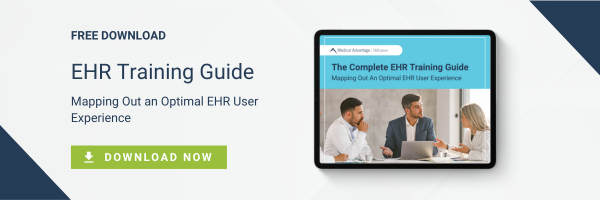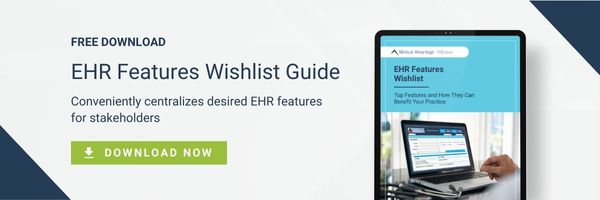Resourceful use of electronic health record (EHR) systems can positively impact patients, care providers and practices in a variety of ways. Increased patient engagement, improved outcomes and streamlined clinical workflows are just a few of the many benefits of a well-configured EHR.
The simplified access to patient health records that EHRs are equipped to provide is not just for convenience, it is mandated by the government. The 21st Century Cures Act Final Rule calls for seamless and secure access, exchange, and use of electronic health information. The rule, “is designed to give patients and their healthcare providers secure access to health information. It also aims to increase innovation and competition by fostering an ecosystem of new applications to provide patients with more choices in their healthcare.”
With the intent to remove barriers between patients and their health data, this Cures Act is specific in how access will be standardized. For example, application programming interfaces allow patients to access electronic health information easily and securely from their smartphone, and that patients can electronically access all their electronic health information at no cost.
Because EHRs are instrumental for compliance and care quality, usability and optimization must be a priority.
Putting the Patient First – Improve Patient Access to Care with Key Patient Portal Features
How does the EHR improve patient access to care? This question is on the minds of many providers. An EHR serves its true purpose when it helps providers deliver quality patient care and improved patient outcomes, such as satisfying interactions through the patient portal.
A full-service patient portal allows EHRs to successfully promote patient engagement by including data visualization charts and graphs, or other aids to help patients better understand progress and automated appointment reminders. This forum also offers a feedback loop through automated patient satisfaction survey requests, that gives patients an opportunity to share their experiences – and you the opportunity to learn from them.
The measure of patient portal success is convenience. If the patient portal includes user-friendly features, patients are more likely to engage in their own healthcare in such a way that leads to better outcomes. Essential patient portal features include:
- The ability to review statements and make payments
- Integrated telehealth
- Remote communication between provider and patient, such as video calls, and secure direct messages
- Remote access to educational information, clinical results, and visit notes
- Electronic check-in and registration solutions with electronic signature capture
- Secure mobile-based app
- Simple integration of remote patient monitoring tools
- Proxy access for adolescents, parents, and caregivers
For even more convenience, the portal may feature online scheduling and prescription refill requests that reduce the need for phone calls for both patients and staff since patients can accomplish these tasks at any time that is convenient for them.
Population health management is another important benefit of an optimized patient portal. Effective individual or group patient management tools monitor patient outcomes, evaluate care quality delivery, and track care groups to keep routine actions on schedule, such as annual flu shots.
Making the EHR Experience More User-Friendly
While your patient portal may be loaded with features, you still may ask yourself, “How do I make my EHR more user-friendly?” One way to uncover usability improvement opportunities to view the EHR from the patient’s point of view. Start by shadowing staff who have patient-facing roles. Walk through your clinic from the perspective of the patient and see how your staff uses your EHR during patient interactions. During your observation, ask staff about their workflows, what feedback they hear from patients, and if they have ideas for improvements.
Consider the following steps of the patient journey in relation to your EHR:
- Is your EHR being used to its fullest potential during check-in, rooming, visit, and check-out to streamline time spent with the patient?
- Are patients given the option and encouraged to fill out paperwork in the patient portal before appointments?
- Do you have a check-in kiosk that can help alleviate long lines?
- Are your patients able to use the patient portal to stay on track with their care plans?
If you still have concerns about your patient portal, it is time to contact an experienced EHR consultant. In fact, even if you do feel satisfied with your EHR’s current performance, you may be surprised what else it can do to add value to your operations, so it helps to bring those curious questions to an expert consultant You also can contact your EHR vendor for additional support if it is available.
Do Not Lose Growth Momentum – Maintaining EHR Best Practices
To ensure that you are getting the most value out of your EHR you must continuously seek opportunities for organizational improvements to maximize practice performance. Collect feedback from all stakeholders, staff included, to pinpoint specific problems and assess your existing training documentation, such as EHR instructions and procedures. Effective EHR training should be personalized to each role within your organization.
Low engagement with the patient portal can also halt the efficacy of the EHR. It is not enough to get your patients signed up with a portal account. You also need them to engage before and after their visit. One way to encourage patients to use the portal is through your staff – train your staff to coach patients on portal use and dispel any assumptions that the portal is too cumbersome to use.
Other ways to encourage more portal engagement include:
- Mass enrollment
- Get your entire staff involved in promoting the portal
- Use patient hand-outs and other materials to encourage utilization
- Customize the content on the portal to the individual patient
- Consider offering a reward, such as a gift card, to incentivize portal engagement
If, like most practices, you do not have the time or resources to update training materials and schedule regular training sessions, you may wish to bring in an outside resource for this purpose. Experienced EHR consultants can step in and serve as an extension of your leadership team for training and education when and where you need them. They also can help ensure that your EHR help aids and training materials are up to date.
While the patient portal is clearly good for patients, it also is good for your organization. By investing in an optimized patient portal – and training for best practices – your practice will benefit from:
- Reduced manual data entry and paperwork processing that take time aways from patients for clinicians and staff. Automated processes reduce clerical burden, freeing up time for providers and staff to improve care quality.
- A competitive advantage because a user-friendly patient portal helps deliver an exceptional and truly patient-centered care process that differentiates your practice from the rest.
- Reduced healthcare costs from early intervention since patient portals improve access and encourage engagement from patients. By tracking patient patterns, providers can readily identify trouble areas sooner.
Summary
When providers unlock the full potential of their EHR, they can elevate the patient experience exponentially. In today’s age of digital convenience, patients expect the same level of ease from their healthcare providers. By ensuring your EHR lives up to the patient experience’s demands, you are investing in the future success of your practice.
Patient engagement is the future of healthcare, and patient portals are essential to creating the experience patients – as consumers – want. The tools to bring the patient experience to the level that consumers have come to expect are available, providers just need to find the time and resources to integrate them into their practice.
By addressing EHR user experience on the practice’s end, you extract even greater value from your EHR. Small quirks with the EHR can add up to a lot of frustration and time wasted by your professional staff. Optimizing your EHR for all stakeholders is a proactive step toward the best care quality and reaching patient outcome goals.
Medical Advantage Can Help
With an optimized patient portal, you reduce hours spent on paperwork and provide a first-rate experience for patients. EHR optimization seeks solutions to all the quirks that keep your practice staff and patients from getting the most value from EHR technology.
For over 20 years, healthcare organizations have partnered with our consultants to create solutions for everything from EHR implementation to enhancing the patient journey – and have seen improvement in care quality across the board as a result. To explore how to get the most from your EHR, reach out to us today.







